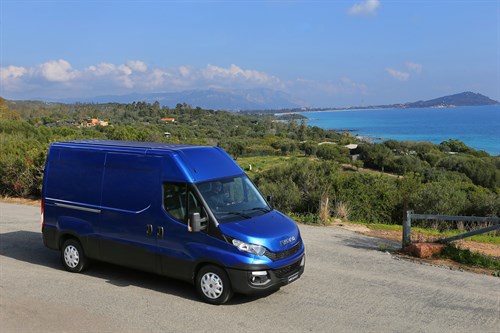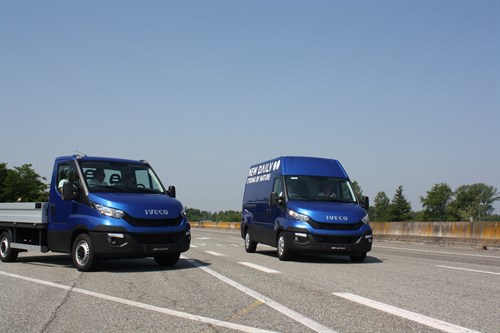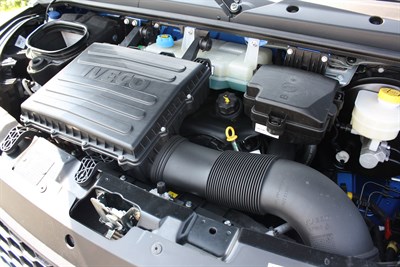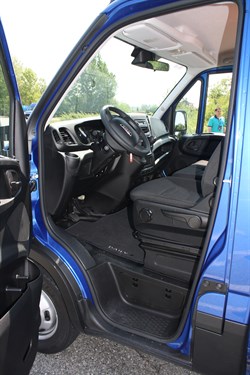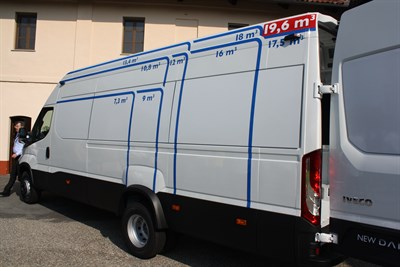An all new Iveco Daily is heading for Australia in 2015. Matt Wood heads to Italy to test out the new cab-chassis and van line-up
Back when the Romans weren’t marching around fighting Gauls, subduing other countries and trying to pretend that Scotland didn’t exist, they also managed to invent some really handy stuff.
Sewers, bridges, roads, gratuitous violence in an arena, toga parties, seductively eating grapes on a couch — many of these important developments came about more than 2,000 years ago thanks to the Roman Empire.
Horses for Chariots
But another interesting thing is the Romans and, more importantly, the size of a horse’s rear end have also had a big impact on transport as we know it today. The wheel track of a Roman war chariot was 1,435mm, which was based around the amount of space that horses harnessed two abreast in a Roman chariot take up allowing for the stability of the wagon itself.
This influenced the width of roads as two chariots or wagons needed to be able to pass each other on a busy road. Many Roman roads had wheel ruts built into them so the chariots could travel at speed with stability. This in turn influenced railway gauges and tram track widths as many early tram tracks in European cities used these ruts to lay the tracks.
These days, the standard American rail gauge is actually still 1,435mm. During NASA’s space shuttle program, the booster components were taken to Cape Canaveral by train, so the rail gauge and tunnels along the route influenced the size of the shuttle’s booster rockets. I know all of this to be absolutely true because a drunken Irishman told me so. Google and Wikipedia pale into insignificance when compared to the wisdom dispensed by an intoxicated Irishman.
This probably has little to do with the new Iveco Daily except that Iveco is headquartered in the north Italian city of Turin, just a few hundred kilometres north of Rome. Oh, and the Iveco Daily is 2,010mm wide, which translates to around one and a quarter Roman war chariots or at least three and a half horse butts across according to my precise calculations.
I’d point out that both Rome and Turin are now in the same country but there still seems to be a little antagonism between the north and south to this very day, so I’ll just say that they are sort of close-ish.
The New Iveco Daily
With 2.6 million Daily vehicles sold since its inception, this new Daily van and light truck platform represents the eighth update of the little rear-wheel drive Iveco since its introduction in 1978, just three years after the birth of Iveco itself.
But quite a few Euro later the Daily has been reborn and the company says it is looking to take on the big seller in the light commercial vehicle (LCV) market.
CNH Industrial APAC Commercial Services Manager Marco Rimondi said at the APAC launch in Turin recently that “our organisation has changed”.
“We want to be the best and we want to be the protagonists of change”.
With 80 per cent new architecture, two new power plants and one new transmission and a full auto on the way, the new Daily was previewed for the Asia Pacific (APAC) region.
For a start, it looks light years better than the old one. I’d go as far to say it would now have to be one of the better looking vehicles of its type on the market.
The frontal styling does give it a rather purposeful look, making it more ‘angry letter box’ than ‘happy doughnut van’, and to be honest this is a welcome move in a market that seems crowded with wonky looking LCVs these days.
Not only is it claimed to be better looking than its predecessor (it is), Iveco also claims the new Daily is more aerodynamic and fuel consumption has been reduced by up to 5.5 per cent.
The Daily has also had some weight trimmed from it, giving the LCV an extra 40kg of payload. A mammoth 19.6 cubic-metre van variant is now also available and wheelbases have been optimised to reduce overhang on longer variants.
The range itself goes out to 7 tonnes gross, which gives the cab-chassis Daily a potential payload of up to 4.7 tonnes and over 4 tonnes for the van taking the Daily well into light truck territory. There’s also a bus variant on offer for the people mover market.
While the architecture of the Iveco may have been largely redesigned, the Daily still sits on a separate sub-frame chassis in the manner of its forebears.
Bringing in the Euros
The APAC region is responsible for 9 per cent of Iveco’s revenue and takes in Russia, Turkey, the Middle East, Asia and of course Australia and New Zealand.
In 2013 Iveco became part of the CNH Industrial Group when Fiat Industrial and CNH merged. Now according to Iveco COO Franco Fusignani “CNH has become a truly global brand”.
Iveco itself was the result of mergers back in 1975, Fusignani says.
“Iveco itself was the first big consolidation in European commercial vehicles and was the integration of five brands,” he says.
CNH Industrial consists of 12 brands that cover the agricultural, construction, mining as well as commercial vehicles. Case IH, Steyr, Case Construction, Iveco, Iveco Bus, Iveco Astra, Magirus, and FPT all fall under the CNH umbrella. The group manufactured 290,000 commercial vehicles in 2013 in 22 plants around the globe including Dandenong, Victoria. The CNH group has 62 manufacturing sites around the world and 48 research and development (R&D) centres.
A Pedigree of Firsts
The Daily does have a couple of firsts in its pedigree. It was the first van with a common-rail fuel system and it was also the first van with independent front suspension.
The new range is expected to show its face Down Under in 2015 though the offroader will stay in its current shape for at least another year or so. Iveco claims the new platform has the lowest load height of any RWD van on the market with the new vehicle 55mm lower than its predecessor.
Iveco Daily Engines
The new engines cover power ratings from 106hp (77.9kW) and 270Nm of torque up to 146hp (107.4kW) and 350Nm for the 2.3-litre F1A. While the 3-litre F1C will go from 146hp (107.4kW) and 350Nm up to 205hp (150.8kW) and 470Nm. In keeping with Iveco’s fondness for natural gas there’s also a compressed natural gas (CNG) model available which develops 136hp (100kW) and 350Nm from its spark ignition set-up.
The 205hp (150.8kW) F1C big banger uses twin turbochargers to feed the 3-litre mill, however it is backed by the old model 6-speed transmission while the smaller donk gets a new 6-speed.
The Agile automated version shouldn’t be too far away while a torque converter auto is reported to be in development and is expected to be an offering on the Australian market. Though to be fair, most of the Italians I spoke to about this were just a little perplexed, I mean who doesn’t like changing gears?
The new Quad-Leaf front end is actually a double wishbone independent set-up with a transverse leaf spring running laterally across it to deal with a maximum load of 1,900kg.
This is reported to have increased roll stiffness and to minimise any duck and dive the vehicle may encounter in an emergency situation.
Daily models over 3.5 tonnes get the Quad-Tor torsion bar front end, and steering geometry has also been revised on the heavier front end. The smallest Daily variant now boasts a turning circle of just 10.5m curb to curb.
Iveco Daily Cabin
The cockpit has also been redesigned and the interior now boasts five covered storage areas, and the driver’s seating position has also copped a makeover.
However, the Daily still doesn’t get a tilt steering column. I’m told this is due to the driver’s airbag and safety concerns regarding the angle of the wheel in an accident. The battery compartment has also been relocated to under the driver’s seat.
An Eco pack is available on the new Daily line-up that includes a startstop function and a soul destroying torque and speed-limiting function.
The options list for the European range is made up of most of the usual extras like climate control, rear vision camera, a touchscreen MP3 Bluetooth sound system with navigation. But also on the European options list is rear air suspension on some models, a Telma electromagnetic retarder, and an air suspended driver’s seat.
The Daily is manufactured at Iveco’s Suzzara plant not far from the Italian city of Milan. The plant has seen a major upgrade for the introduction of the new model including added automation.
The other major Daily manufacturing centre is in Valladolid, Spain. Owner//Driver got some face time with the new vehicle at Fiat’s Balocco proving ground just out of Turin. A loaded cross section of the range was on-hand and both new engines were test driven — the new transmission and the revised front end in a variety of conditions from a high-speed loop to emergency braking and low-speed manoeuvrability.
The cockpit of the new Daily is well set out and a nice place to be and everything is where you need it to be.
Like most of its European contemporaries the manual gear shift is also well-positioned and intuitive to use. Document storage, cup holders and storage bins are also well placed for the working day.
Sweet Spot
It didn’t take long to identify the sweet spot in the Daily range. The lighter duty 35-150 has benefited significantly from new developments. The 106hp (77.9kW) 2.3-litre engine was a willing performer and backed by a new slick shifting 6-speed tranny which made the whole driveline a nice package. But the best test of any LCV is handling at speed with some weight on its back and again the little 35 was a standout, something I put down to the characteristics of the quad-leaf front end.
On tight undulating curves the 35 handled so beautifully I even cut the apex of a few turns and dropped a wheel off the tarmac at speed to see how the Daily would cope but it refused to be unsettled.
Jumping behind the wheel of the larger 3-litre variants also showcased the agility of the revised platform. However, the older transmission from the previous model that has been slotted behind the new engine takes some of the gloss off the package. A car-like driving experience is what Iveco promotes in the Daily, however, with the heavier tranny, the shift is slower and you can feel some driveline kickback through the stick. It also gets a little noisy when worked hard.
Admittedly the larger 7-tonne cab-chassis is in light truck territory rather than in the automotive domain, but it still lacks some finesse when compared to some of its European and Japanese competition.
Yet it was the top of the power tree 205hp (150.8kW)/470Nm twin turbo that really stood out in the heavier Daily variants. Enough so I was prepared to overlook the less civilised feel of the older cog-box. Really, this is about as sporty as it gets for a truck journo.
In a standing 400m sprint the largest van variant on super single wheels had a terminal speed of 115km/h and comfortably maintained 160km/h on the high-speed circuit with a good couple of tonnes in the back.
Pedal layout and plastic panelling in the driver’s footwell were a bit of a gripe as I kept snagging my feet on parts of panels as I drove, especially during emergency braking manoeuvres. Admittedly, most won’t come across this in everyday use on the road.
Iveco Daily in Australia
National Manager of Iveco’s truck and bus business for Australia and New Zealand Steve Heanes, along with National Key Account Manager Lloyd Reeman, confirmed most of the Australian line-up for the new Daily has been locked in and ready for a local launch in 2015.
The aim, according to Reeman, is to initially replicate the existing local line-up. The dual cab-chassis remains popular in Australia and according to Heanes the sales split between cab-chassis and van variants of the Daily are currently 70 per cent cab-chassis and 30 per cent van.
No doubt much of this can be attributed to the motorhome market as well. Locally the company is focused on building brand perception in the wake of the CNH merger.
Overall the new Daily appears to be a neat LCV package with some real standout models in the range. It will be here before you can learn to say “more Limoncello” in Gaelic.



